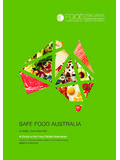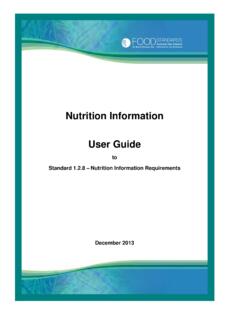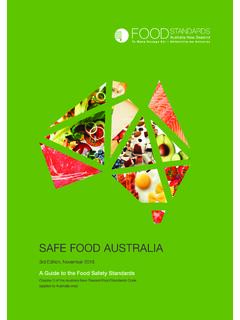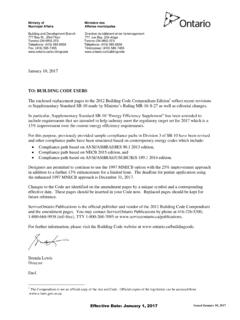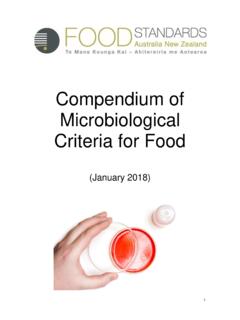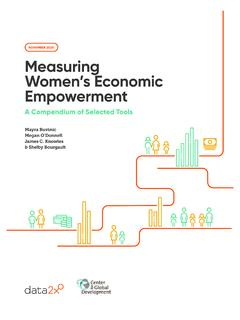Transcription of Compendium of Microbiological Criteria for Food
1 Compendium of Microbiological Criteria for Food September 2018 2 Compendium of Microbiological Criteria for Food, September 2018 Food Standards Australia New Zealand 2018 ISBN: 978-0-642-34594-3 Published October 2016, Updated September 2018 Food Standards Australia New Zealand (FSANZ) supports and encourages the dissemination and exchange of information. Information in this publication is provided under a Creative Commons Attribution Australia (CC BY ) Licence, except for the Food Standards Australia New Zealand logo. An electronic version of this work is available on the FSANZ website at and, for New Zealand, Attribution You may copy, distribute, transmit and adapt the material in this publication by the CC BY licence for commercial and non-commercial purposes; but you must attribute the work in the following manner: Food Standards Australia New Zealand.
2 This attribution must not, in any way, suggest that FSANZ endorses you or your use of the work. For more information email Australia PO Box 5423 Kingston ACT 2604 AUSTRALIA Ph: +61 2 6271 2222 Fax: +61 2 6271 2278 New Zealand PO Box 10559, The Terrace WELLINGTON 6143 Ph: +64 4 473 5630 Fax: +64 4 473 9855 xx 2018 3 Compendium of Microbiological Criteria for Food, September 2018 TABLE OF CONTENTS Introduction .. 5 SECTION 1 .. 6 Microbiological guideline Criteria for RTE foods .. 6 Background .. 6 Purpose and scope .. 6 Microbiological 6 Summary of bacterial pathogen/food associations .. 7 Interpretation of results .. 9 Table 1. Interpreting results for testing of pathogenic microorganisms in RTE food ..10 Table 2. Interpreting results for testing of indicator organisms in RTE foods ..16 Table 3. Interpretation of results for standard plate counts in RTE foods.
3 18 SECTION 2 .. 20 Process hygiene Criteria .. 20 1. Powdered infant formula products .. 21 Process hygiene Criteria ..21 Microbiological specifications ..22 References ..22 2. Meat products .. 23 Raw chicken meat ..23 Process hygiene Criteria ..23 Method of analysis ..25 References ..25 Attachment 1 ..27 3. Dairy products .. 32 Raw bulk milk ..32 References ..33 Processed liquid milk and cream ..33 Environmental monitoring program ..33 Process hygiene Criteria ..34 Method of analysis ..35 Cheese (heat-treated milk) ..35 Heat treatment ..36 Environmental monitoring program ..36 Verification of critical limits ..36 Process hygiene Criteria ..37 Method of analysis ..38 Reference ..38 4 Compendium of Microbiological Criteria for Food, September 2018 SECTION 3 .. 39 Environmental monitoring .. 39 1. Environmental monitoring program for Listeria monocytogenes.
4 39 Target organisms ..39 Sample sites ..39 Frequency of sampling ..40 Actions in the event of positive results ..40 References ..42 APPENDIX 1 Pathogens .. 43 Bacillus cereus & other Bacillus spp..43 Campylobacter spp..45 Clostridium perfringens ..47 Listeria monocytogenes ..49 Salmonella spp. (non-typhoidal) ..51 Shiga toxin-producing Escherichia coli (STEC) ..53 Staphylococcus aureus and other coagulase-positive staphylococci ..55 Vibrio parahaemolyticus ..57 APPENDIX 2 Indicator microorganisms .. 59 Enterobacteriaceae ..59 Coliforms ..61 Escherichia coli ..62 Standard Plate Count (SPC) ..63 Listeria spp..64 5 Compendium of Microbiological Criteria for Food, September 2018 Introduction Microbiological Criteria are established to support decision making about a food or process based on Microbiological testing. Criteria can be developed and applied for different purposes across the food supply chain, with different consequences if the limits are not met.
5 Internationally, the Codex Alimentarius Commission (Codex) and the International Commission on Microbiological Specifications for Foods (ICMSF) have provided the lead on contemporary food safety management approaches and applying Microbiological Criteria . An important principle is that a Microbiological criterion is established at a specified point in the food chain for a particular purpose. In general, this is to establish the safety of a food or to verify that the food safety control system or elements of it are working as intended. The Microbiological Criteria used by food regulatory agencies generally include: food safety Criteria : Microbiological Criteria that are applied to determine the safety of a food lot. Food safety Criteria are included in the Australia New Zealand Food Standards Code (the Code) and are applied to food for sale ( at any point following final product manufacture).
6 Process hygiene Criteria : Microbiological Criteria applied to verify hygiene measures or control of process. Process hygiene Criteria are included in Section 2 of this document. They are applied at a specified point in the manufacturing process. Microbiological guidelines are also used by regulatory agencies to check that food for sale is safe and suitable and the food handling controls and hygienic practices of a food business are adequate. Guideline Criteria indicate whether the Microbiological status of a food product is within the normal/acceptable range and in this way are alert mechanisms to signal conformance with food safety controls. Microbiological guideline Criteria for ready-to-eat (RTE) foods are included in Section 1. Food businesses may also establish process hygiene Criteria and Microbiological guidelines for their operations as well as setting Microbiological specifications for raw materials and ingredients or finished products.
7 A Microbiological specification is a criterion applied as part of purchase arrangements to determine acceptability of ingredients or foods as required for ensuring product safety or quality. This Compendium brings together information on pathogens and indicator organisms significant to food safety, Microbiological guideline Criteria for RTE foods, and process hygiene Criteria that have been established for specific food commodities. 6 Compendium of Microbiological Criteria for Food, September 2018 SECTION 1 Microbiological guideline Criteria for RTE foods Background Ready-to-eat (RTE) foods1 are intended to be consumed without any further process by the final consumer that may eliminate or reduce pathogenic microorganisms that could be present to a safe level. They may be commodity based ( dairy or meat products), but commonly include a combination of ingredients from more than one commodity group.
8 The safety and suitability of RTE foods should be ensured through adherence to food handling controls and good hygiene practices that prevent or minimise contamination by and growth of pathogenic microorganisms. In Australia these food safety requirements are set out in Chapters 3 and 4 of the Code. In New Zealand, the Food Act 2014 and Animal Products Act 1999 and associated regulations specify food handling controls. In this context, Microbiological testing can be useful in checking/verifying whether food safety controls are in place and working as intended. Purpose and scope Food samples may be taken for a variety of surveillance and monitoring purposes. When Microbiological testing of food samples is carried out it is important that relevant tests and suitable limits are applied so results are interpreted correctly and consistently. The purpose of this section is to: provide information on which Microbiological tests apply to RTE foods, based on their characteristics and processing factors outline Criteria for assessment, including limits for interpreting results provide an indication of the type of follow-up actions to be taken in response to findings.
9 The reference limits provided allow an assessment of a single or multiple samples. They are not intended to be sampling plans for the acceptance/ rejection of food lots, but used for evaluating food handling controls. The guideline Criteria for RTE foods provided in this document are not intended to be used for food products for which food safety Criteria have been established in the Code. Process hygiene Criteria for specific foods/commodities are provided in Section 2. Microbiological tests As RTE foods include a wide range of products, the decision on what Microbiological test to apply will depend on a number of factors: the type of ingredients used whether ingredients are cooked or raw the cooking or other processing involved in manufacture the level of handling after cooking or processing whether the food requires temperature control for safety ( the characteristics of the food, such as pH and water activity, allow the growth of pathogenic microorganisms) presence and type of packaging shelf life.
10 1 Ready-to-eat food is defined in Standard of the Code. 7 Compendium of Microbiological Criteria for Food, September 2018 Appendices 1 and 2 provide information on pathogens and indicator microorganisms/tests significant to food safety. A summary of bacterial pathogen/food associations for those microorganisms routinely tested and applicable to RTE foods is provided below. Laboratory methods are not specified in this section. The method used will depend on the reason for testing and factors such as speed, sensitivity, whether identification or quantification is required, as well as cost. For regulatory testing against food safety Criteria in Schedule 27 of the Code, Standard specifies reference methods to be used. For other testing, validated methods should be used. Summary of bacterial pathogen/food associations Pathogen Associated foods Why Bacillus cereus Cooked foods such as: rice dishes including sushi potato and pasta dishes meat, vegetable and fish dishes (stews, curries etc.)


